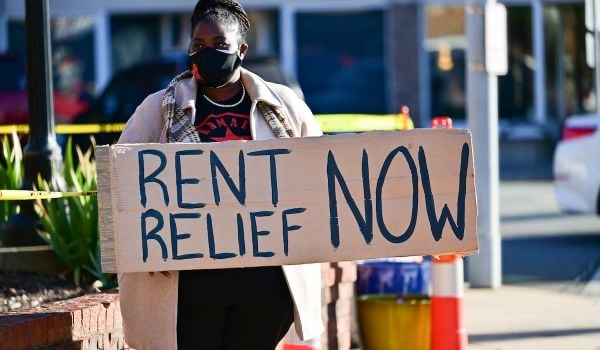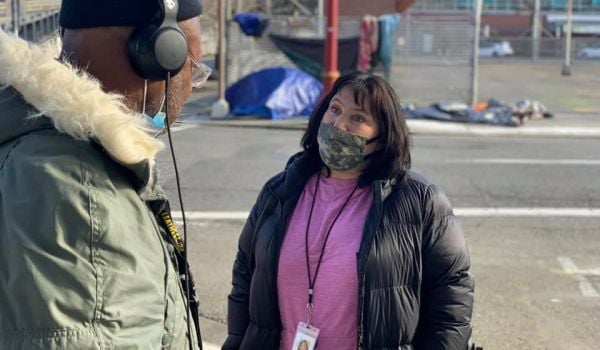Standardized homelessness intake forms are intended to make sure that everyone who is homeless or at risk of homelessness gets treated fairly and routed to the type of assistance that best matches their needs.
But as with many systems, the effects of racism elsewhere were causing the seemingly neutral form to have non-neutral results.
Joselyn Wilkinson, principal at the BLK House Group for Housing and Community Development and a member of the Arizona Governor’s Interagency and Community Council on Homelessness and Housing, was a housing specialist at a company called HOM, Inc. before the pandemic. HOM contracts with nonprofits and government agencies to carry out two kinds of housing placements: rapid rehousing, where households are placed into a private apartment with short-term rental support, and permanent supportive housing, a longer-term housing solution that comes with services.
Watching who was going into which program, Wilkinson noticed something concerning.
“The Black and Brown families were in rapid rehousing and all the white folks were in permanent supportive housing,” she recalled. “I visually saw it for three years working as a housing specialist.”
Wilkinson was not the only one who noticed. She and other specialists eventually found the culprit—the intake questions on something called the VI–SPDAT. That stands for Vulnerability Index–Service Prioritization Decision Assistance Tool. It contains questions intended to help identify how difficult someone’s situation is when they enter the homelessness system, which then allows organizations like HOM to figure out how best to serve each person.
There had been previous assessments that suggested that intake questions were leaving vulnerable people behind, so a subcommittee on gaps and barriers was created through the Maricopa Association of Governments Continuum of Care, which receives and coordinates federal homelessness relief funds from agencies like the Department of Housing and Urban Development. The committee went through each question to understand what could have been deprioritizing people of color compared to their white counterparts. They found multiple culprits.
First, although the assessment asked questions about mental health diagnoses, non-white families and people were less likely to express that they had a mental health condition related to their financial and housing situation, even when they did. There were a few reasons for this.
“Specifically for the Black community … mental health is just a taboo subject,” says Wilkinson, who is Black. “We don’t talk about it. We address our mental health by going to church, living in our faith—just other outlets. So, when asked those questions, it’s ‘No, I don’t have a mental health issue.’”
Differences in access to care also played a role. A 2017 report from the American Psychiatric Association outlines how Latine and Black communities were less likely to look for and use mental health services. Most therapists in the U.S. are white, which creates further barriers to access for communities that have historically been treated unequally.
Taken together, these factors mean that when people who were completing intake assessments were asked if they had mental health struggles, many answered “no” when a white person experiencing similar symptoms would have said “yes.” This disconnect would lower their vulnerability score and disqualify them for long-term housing assistance.
Evictions and justice system involvement
“One of the other questions that was pushing families [of color] into temporary housing intervention is the question around evictions and criminal history,” says Wilkinson.
A history of either worked against the families looking for support, which she said was frustrating because both factors made individuals and families more vulnerable to housing insecurity. Counterintuitively, in the current system, having either of those risk factors counts against you in terms of receiving permanent supportive housing. Despite the assessment being called a “vulnerability index,” Wilkinson notes that because it deprioritizes people with evictions and justice system involvement, it feels as if it, like many support systems, was set up to divert help toward people who appear almost perfect on paper, rather than toward the most vulnerable.
It also reinforces racial disparities, because disparities already exist in both of those systems. According to research from the Vera Institute, one in three Black men born in 2018 are likely to be incarcerated, compared to one in 17 white men. The disparities hold for women as well: One in 18 Black women born in 2001 will be incarcerated versus one in 111 white women. A 2023 study from the American Civil Liberties Union found that in at least 17 states, Black women renters were about twice as likely to have eviction notices filed against them as white women renters.
Asking better questions
The VI-SPDAT assessment has been under fire for a few years due to race and gender disparities that come out of its use. To Wilkinson’s knowledge, many organizations and agencies still use it as a guide for placing people who are experiencing homelessness and other issues into support programs.
But she says that many organizations are working to phase it out, especially as more people point out the divide between how different communities are affected as a result.
Even where the assessment still in place, some organizations have changed how they use it. Some have supplemented the VI-SPDAT with other questions to get the most vulnerable applicants more accurately and fairly matched with care that fits their needs.
In Maricopa County, says Wilkinson, they are piloting some changes to the intake form, replacing some existing questions with new ones of their own. For example, since they know that people of color are less likely to receive a formal mental health diagnosis even if they are struggling, that question was eliminated. Arizona’s intake assessments instead will ask if someone needs extra support and list some of the services available, including options like behavioral health care and financial management assistance. Wilkson says other counties are discussing what changes could look like for them.
Maricopa County has also adjusted its scoring, giving additional points toward permanent housing support for having experienced eviction or justice system involvement, rather than having those factors count against someone.
“Ours is really focused on the person experiencing the homelessness, rather than … telling people what we think [they] need to get out of the situation,” Wilkinson says.
“There is so much historical, racial disparity in so many systems that we’re still trying to break down and rebuild.”
This story was co-published in collaboration with Shelterforce, the only independent, non-academic publication covering the worlds of affordable housing, community development and housing justice.
This article is part of Backyard, a newsletter exploring scalable solutions to make housing fairer, more affordable and more environmentally sustainable. Subscribe to our weekly Backyard newsletter.
Angely Mercado is a New York City-based independent journalist, researcher, and fact-checker. Her work explores the intersection of environmental justice, racial justice, sustainability, fintech, and culture.
Follow Angely .(JavaScript must be enabled to view this email address)



















Add to the Discussion
Next City sustaining members can comment on our stories. Keep the discussion going! Join our community of engaged members by donating today.
Already a sustaining member? Login here.